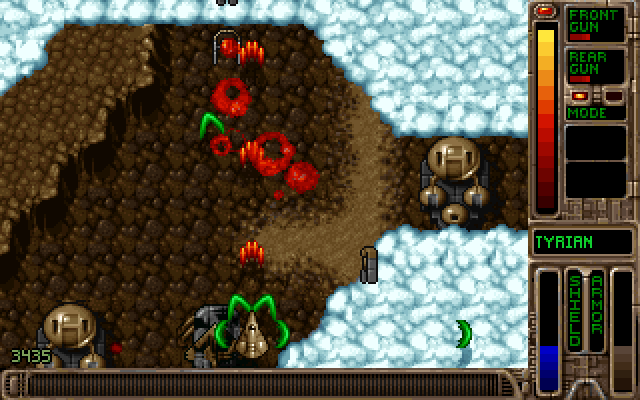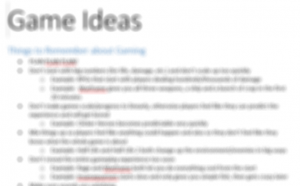In future episodes, I’ll be breaking down individual components, mechanics, features, techniques, and lessons, but now I’m going to talk about the reasons and ideas behind Zyrian. But before I do, let me give you a better picture of where I was at heading into this thing.
I began programming casually in my early teens after stumbling upon an old book on QuickBASIC. Before returning to university in 2014, I had a decent grasp of simple programming concepts like variables, conditionals, and loops, but I knew nothing of software design, algorithm analysis, and object-oriented programming. I had dabbled with Visual Basic, but I still only knew one language.
After a year and a half of both classroom and self-directed learning, I knew a lot more about programming. However, I still had no knowledge of game design. I didn’t even know what a game loop was. The only “games” that I’d made were either text-based or point-and-click and were borderline unplayable.
Like many amateur game programmers, I had previously confused making a game with making a game engine. I couldn’t help it – I really wanted to know how things worked. But after listening to tutorial after tutorial tell me to use an existing game engine, I decided to give it a try. After little to no research, I chose Phaser – an open source JavaScript framework.
Okay, now back to the reasons and ideas behind Zyrian.
The Why
I don’t know if I ever explicitly contemplated the reasons for making this game, but if I had, they would have been something like this:
- Learn to use a game library
- Improve on some of Tyrian’s features
- Make a game that people might actually play
- Finish something
After numerous half-butted attempts at creating games over the years, this one was different. I had some education behind me, I had a plan, and I was motivated to make something I would be proud of.
Now I’ll talk about some of the main ideas I had about the game I wanted to make.
Features to Keep
There’s a lot of cool stuff in Tyrian. In addition to the beautiful graphics, interesting content, and a neat power consumption mechanism mentioned in the introduction, Tyrian also has engaging music, satisfying sound effects, a simple and effective menu, front and rear weapons, shields, sidekicks, and alternate game modes (including two-player).
I didn’t want to include every feature. After all, some of them seemed pretty advanced for a newbie. I also didn’t want to make my game too similar to the original. Here are the features that I decided were important to keep:
- Two sets of weapons
- Power consumption mechanism
- Shields and crash damage
- Items, money, and shopping
Numbers & Stats
As a fan of role-playing games, I love stats. I love equipment, leveling, talents, and skills. And so one of my ideas was to bring RPG elements into the scrolling shooter genre, like how Borderlands brought it to the first-person shooter.
Although Tyrian has some RPG-like features, it gives only vague indications about stats and numbers, so it’s extremely difficult to determine whether one item is superior to another. This is mostly true of the weapons, which are by far the coolest and most important items in the game. I believed that incorporating more RPG elements would add depth to my game.
Randomization
Another feature often associated with RPGs is randomization, and I wanted to use it in the game. The main areas that I thought would benefit from randomization were the items, enemies, and missions. This would make the gameplay experience a lot more diverse, which would increase the replay value. I also thought that it might be easier to create a random mission generator than to create dozens of missions.
Item Balancing
In addition to randomizing the items, I also wanted to balance them.
If you’ve ever played Tyrian, you probably know that you should begin the game by upgrading the Pulse-Cannon (which you start with) and getting the Sonic Wave. These weapons aren’t just great for the first mission, they’re great throughout the entire game.
This really sucks, because the game has a ton of other cool weapons, but almost all of them are worse than the Pulse-Cannon and Sonic Wave, and many of them are just terrible.
Economy
Another issue that becomes clear after playing the game for a while is the diminishing value of money.
Early in the game, you’re careful to kill every enemy and pick up every coin in order to gain as much money as possible. And this has a big impact on the game, because it means you can upgrade your weapons and buy other cool stuff.
But once you’ve maxed your weapons and bought the best ship, shield, generator, and sidekicks, there isn’t any reason to get more money. And this makes the game noticeably less fun. Many other games are guilty of this as well, including award-winning modern titles.
I wanted to make sure that the player always wanted to get more money. I thought that randomization, levels, and scaling would help.
Factions
One design idea I had was to introduce factions to the game. Factions would determine the appearance and stats of items, have their own reputation or currency, and also make the story a little more interesting. I decided on five factions:
- The corrupt empire
- The angry rebels
- The peaceful pagans
- The neutral traders
- The marauding warriors
I didn’t know what to call them, so I just used some placeholder names of Empire, Revolt, Preserver, Freelancer, and Eclipse.
Mission Maker
I also thought it would be cool to let players design their own levels. I had no idea how it was going to work, but I thought I’d try to make a graphical mission maker and incorporate it into the game somehow.
This post may make it seem like I had everything planned out and knew what I was doing, but all I had was a huge list of ideas and no idea how to implement anything. These were just the core ideas I knew I wanted to have in the game.
Stay tuned for more!

